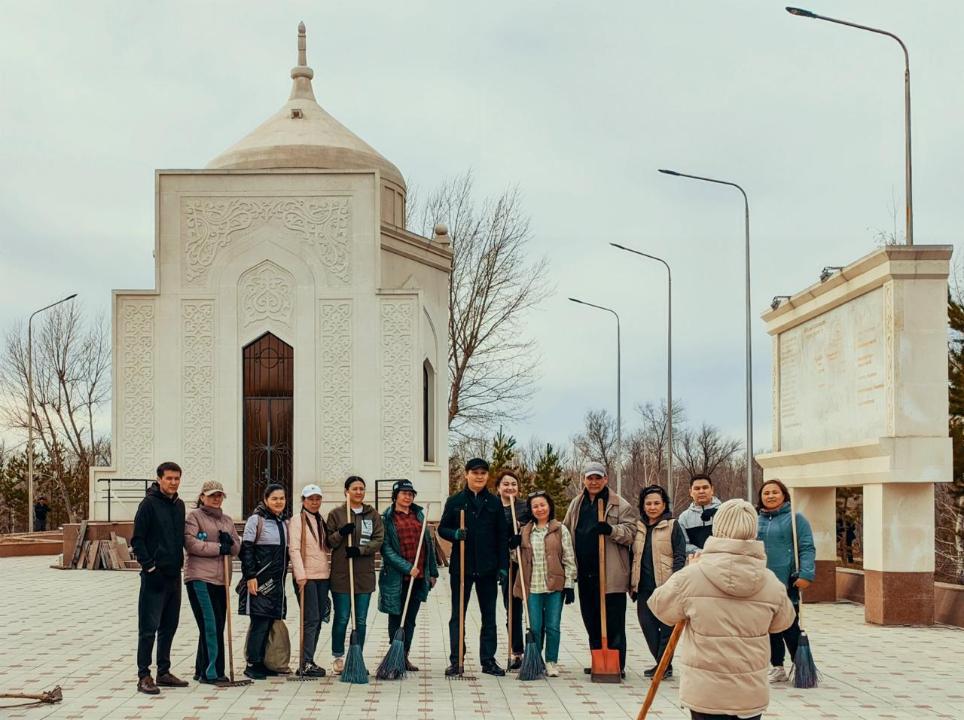ASTANA—The Taza (clean) Kazakhstan environmental campaign, which is devoted to landscaping efforts around historical and cultural monuments, has attracted nearly 770,000 people across the country, including diplomats, to 3,700 events in its second week on April 15-20, reported the Kazakh Ministry of Culture and Information.

Photo credit: Kazakh Ministry of Culture and Information
By the end of the campaign’s first week, devoted to cleaning adjacent areas and courtyards, in all 17 regions of the country, 2,839 streets had been cleared, and 139,250 seedlings had been planted. At least 144,430 trees were whitewashed, 58,407 square meters of footpaths and 272 kilometers of rivers and stream beds were cleared. More than 1,600 tons of garbage in the Almaty region and 679 tons in the Zhetisu Region had been removed. Some 34,500 flowers had been planted in the Turkestan Region.
Throughout the second week, 717 sites were cleaned and restored.
Diplomatic engagement and collaboration
In Astana, the territory of the Kerey and Zhanibek Khans monument was cleaned by pop artists of Kazakhstan, as well as on the Writers Alley with the participation of deputies of the maslikhat (local representative bodies), members of the Writers’ Union, secondary school students and library staff.
Japanese Ambassador to Kazakhstan Yamada Jun and embassy representatives collaborated with locals to clean the territory surrounding the monument to the memory of Japanese internees in Astana. They also planted 50 trees, including birches, pines and lilacs.
Expressing gratitude to the residents of the Nura district in Astana, the ambassador emphasized the importance of preserving shared history and memories.
“It is a great honor for the embassy staff to participate in the clean-up as residents of the capital. Astana is a common and native home for all of us, so we must keep our city clean,” said Jun.
Innovative eco-friendly initiatives
In Almaty, Central Park introduced a new photo zone made from disposable tableware and an installation of fish designed to collect and dispose of plastic waste. Additionally, Almaty opened its newlyweds’ alley in Gulder (flowers) Park where they were offered to plant a tree as a sign of their union.
Over 300 people in Ust-Kamenogorsk have contributed to cleaning the territories of an ethnic village, a zoo and an alley featuring World War II military equipment. The participants of the initiative also plan to plant seedlings of cabbage, peppers, beets, carrots and potatoes in summer. Later, the whole harvest will be given to the zoo for animal feed.
Highlights of regional restoration efforts
The youth of Kokshetau city directed their cleaning and landscaping efforts to freshen the monuments of Kazakh scholar and ethnographer Shokan Ualikhanov and firefighter Askar Zabikulin, who saved three people by sacrificing his own in November 2022.
In the Turkistan Region, sites such as the Otyrar Museum, the Bulanty Shaikasy historical and cultural site, the Tamgaly Tas archaeological complex, and the Mausoleums of Khoja Ahmed Yasawi, Ukash Ata, Zhusup Ata, Iskak Baba and Baba Tukti Shahty Aziz sites were cleaned and restored.
Volunteers in the Zhambyl Region discovered Bronze Age petroglyphs, adding to the region’s cultural heritage.
In the Ulytau Region, over 4,000 people cleaned up the territories of historical and cultural sites such as Zhoshy Khan, Terekty-Aulie, mausoleums of Alashakhan, Dombaul, and local memorial squares. During the cleanup efforts, 65 unauthorized landfills were eradicated and new garbage containers were installed. Additionally, withered branches of 632 trees were pruned, and 405 trees were planted.
In the Abai Region, nearly 400 people participated in cleanups of monuments, including Zere ana (grandmother of Kazakh poet and philosopher Abai Kunanbaiuly), Kazakh poet and novelists Kalikhan Altynbayev, and Tursynkhan Abdrakhmanova at the Dank (glory) Alley. Some 38 memorial complexes, monuments, and obelisks dedicated to the soldiers of World War II have been cleaned in the Zharma district.
In the Karagandy Region, public activists, volunteers, students and schoolchildren united for landscaping and cleaning efforts across more than 40 historical sites. These activities included washing commemorative plaques on the Alley of World War II Heroes, removing garbage and fallen leaves at the Eternal Flame memorial complex, cleaning the square dedicated to political repression victims in Osakarovsky district, improving the square of railway workers in Sortirovka district, tending to the monument to internationalist soldiers in Saran district and tidying up the territory near Kunanbai mosque.
The Mangystau Regional Philarmonic and Kabibolla Sydykov Library employees joined forces to clean the Koshkar Ata necropolis, located 17 kilometers from the Aktau city. The necropolis, housing 81 monuments, is listed as a historical and cultural monument of local significance and as a sacred site of regional significance in the Mangystau region.
The third week, ending on April 27 will be focused on planting tree seedlings and whitewashing greenery. Activities until May 4 will focus on cleaning and landscaping the yards of elderly people and the areas of nursing homes. The final fifth week will prioritize clearing debris from the surroundings of water bodies such as rivers and lakes.

